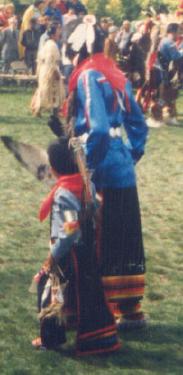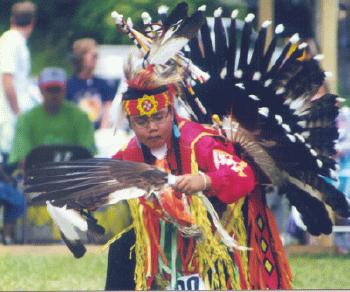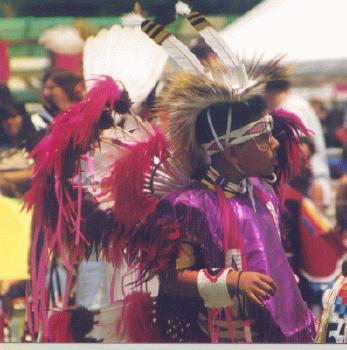|
|
Pow Wow Dance Styles
by Vicki Lockard third in a series
Photos by Paul Barry and Jamie Lockard
|
Dancing creates excitement at powwows! Men's Straight Dance A Straight Dancer's regalia consists of nearly twenty items, either closely coordinated or matched as sets. Dancers wear satin, brocade or floral-print ribbon shirts with contrasting ribbon. Neckerchiefs, scarves and arm-band ribbons match the shirt's ribbon. A white scarf may be used as a headband. Leggings vary according to the dancer's tribal affiliation. Most Straight Dancers wear aprons and leggings made of heavy trade wool. Red wool is reserved for the eldest son. Most others choose dark blue. Straight Dancers carry mirror boards or a tail stick in their right hands. The tail stick began as a Tail Dancer's badge of office in Hethuska Society. It is usually passed on from an experienced dancer. Smoothness, precision, knowledge of dance etiquette, and a tremendous sense of pride belong to the Straight Dancer.
Traditional Dancers wear traditional regalia. A choker is worn around the neck. Most dancers wear shirts, with or without ribbons, and a breastplate over the shirt. On his head he might wear a roach, quilled wheels, or a beaded headband. Traditional Dancers may carry a variety of objects. Most common is a fan made from the wing of an eagle or hawk. The dancer uses the fan to provide a cooling breeze on the hot, summer days. Breech cloths or aprons can be plain or heavily decorated. The Traditional Dancers might wear knee bands, sometimes with bells, and fur wrapped around his ankles. On his feet, he usually wears beautifully beaded moccasins. Each dancer's regalia is a reflection of his own style and tradition. Please respect and
honor these personal expressions that The Fancy Dancer wears heavily loom beaded suspenders, cuffs, belt cuffs, headband and armbands. His pattern is usually matched in all of the beadwork and may be of a rainbow feather or geometric design. He also may wear beaded medallions on his forehead and bustles. One big part of the Fancy Dance regalia is the use of a large feather bustle. Many of these bustles are color-coordinated with the beadwork and use a lot of feather hackles dyed the right color. Trailers hang from the bottom bustle. These usually have ribbon work and are made of navy, black or red trade wool. On his head, the Fancy Dancer will have a porky/deer-tail roach with two feathers attached to a rocker. He will have chokers of bone hair pipes, silk scarves, or beaded strips. Many times, the Fancy Dancer will use face and leg paint. He carries a loose or flat fan. Fancy Dancers are known for their stamina, high jumps and quick footwork. Combined with
the beautiful regalia, the Fancy Men's Grass Dance
The Grass Dancer's regalia is unique in that it has almost no feathers. It consists of a shirt and trousers that have fringe attached. Usually, the fringe is made of long pieces of colorful yarn. His apron is one of the most decorative parts of his regalia. The front breechcloth is often decorated with beadwork and/or ribbonwork. The back apron will have ribbons sewn into a V that will hang loose for 2 or 3 feet. Another beautiful part of his regalia is a beaded harness that goes from the shoulders to below the knees. Most Grass Dancer's wear a porcupine hair roach attached to a head harness. This headdress is often quite elaborate. In his hand, the Grass Dancer will carry fans, mirror boards or dance hoops. The Grass Dance has been described as "gutsy, swinging, slick, and old-time."
The swaying motion is quite different from |
|
|
| Canku Ota is a free Newsletter celebrating Native America, its traditions and accomplishments . We do not provide subscriber or visitor names to anyone. Some articles presented in Canku Ota may contain copyright material. We have received appropriate permissions for republishing any articles. Material appearing here is distributed without profit or monetary gain to those who have expressed an interest. This is in accordance with Title 17 U.S.C. section 107. |
|
Canku Ota is a copyright of Vicki Lockard and Paul Barry. |
|
 The Straight Dance is a Southern, or Oklahoma, style dance evolving from Hethuska dances (those performed
by different societies). Straight Dancers are distinguished by regalia and dance styles. Regalia items are closely
matched and coordinated. Dancers move in a very slow and proud way.
The Straight Dance is a Southern, or Oklahoma, style dance evolving from Hethuska dances (those performed
by different societies). Straight Dancers are distinguished by regalia and dance styles. Regalia items are closely
matched and coordinated. Dancers move in a very slow and proud way. Men's Traditional Dance is a popular, Northern style form. Traditional Dancers preserve the "old
Sioux way" of dancing, making it the oldest form of Native American Dancing. Traditional Dancers combine drama
and grace to tell their stories. Their dances are those of the warrior on the hunt or in search of enemies.
Men's Traditional Dance is a popular, Northern style form. Traditional Dancers preserve the "old
Sioux way" of dancing, making it the oldest form of Native American Dancing. Traditional Dancers combine drama
and grace to tell their stories. Their dances are those of the warrior on the hunt or in search of enemies. Men's Fancy Dance began as a Fancy War Dance by the Hethuska society in Oklahoma. Gus McDonald, a
Ponca, invented the dance and was the first World Champion Fancy War Dancer. Today, the McDonald family is still
honored by having an honor song sung in recognition of their gift to Native America.
Men's Fancy Dance began as a Fancy War Dance by the Hethuska society in Oklahoma. Gus McDonald, a
Ponca, invented the dance and was the first World Champion Fancy War Dancer. Today, the McDonald family is still
honored by having an honor song sung in recognition of their gift to Native America. The Grass
Dance evolved from a warrior society dance. Although the origin of the Grass Dance is not really known, it is thought
to have come from the Omaha, or earth lodge people of the Missouri River area. The earliest pictures and descriptions
of the Grass Dance were done by George Catlin, in 1836.
The Grass
Dance evolved from a warrior society dance. Although the origin of the Grass Dance is not really known, it is thought
to have come from the Omaha, or earth lodge people of the Missouri River area. The earliest pictures and descriptions
of the Grass Dance were done by George Catlin, in 1836.